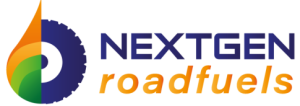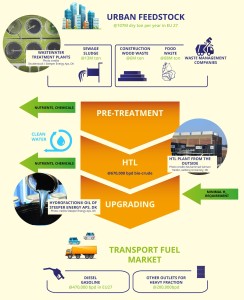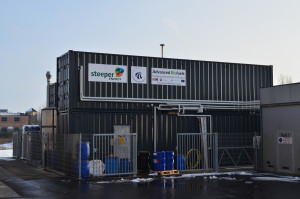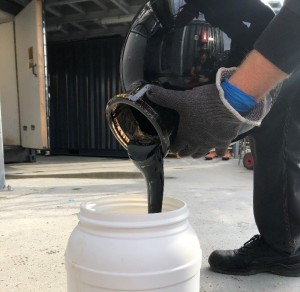 NextGenRoadFuels is a Research and Innovation project funded by the Horizon 2020 programme to develop a cost-effective valorisation pathway for multiple urban waste streams such as sewage sludge from treated wastewater, food waste and construction wood waste. These waste streams will be converted into renewable fuels, fertilizers and proteins, thus fostering the urban transition towards a circular economy. Started in 2018 with a consortium of thirteen partners coordinated by the University of Aalborg, the 4-years project will prove the Hydrothermal Liquefaction pathway (HTL) as an efficient route to produce high-volume, cost-competitive, drop-in synthetic gasoline and diesel fuels, as well as other hydrocarbon compounds.
NextGenRoadFuels is a Research and Innovation project funded by the Horizon 2020 programme to develop a cost-effective valorisation pathway for multiple urban waste streams such as sewage sludge from treated wastewater, food waste and construction wood waste. These waste streams will be converted into renewable fuels, fertilizers and proteins, thus fostering the urban transition towards a circular economy. Started in 2018 with a consortium of thirteen partners coordinated by the University of Aalborg, the 4-years project will prove the Hydrothermal Liquefaction pathway (HTL) as an efficient route to produce high-volume, cost-competitive, drop-in synthetic gasoline and diesel fuels, as well as other hydrocarbon compounds.
The project is fully aligned with the SET Plan Key Action 8 on renewable fuels, which calls for an acceleration of the development and deployment of low-carbon technologies in the transport ector. NextGenRoadFuels will also contribute to the renewable-energy-in-transport target, as well as to the GHG emissions reduction objectives, in line with the Renewable Energy Directive (RED II) and the European Energy Roadmap 2050.
Feedstock pre-treatment, nutrient recycling and water management

The approach of NextGenRoadFuels starts from urban feedstock collection: sewage sludge, food waste and construction wood waste will be used as feedstock for the HTL process. Sewage sludge has exponentially increased and is estimated to exceed 13 million dry tons by 2020 in European countries. The choice of using urban residues as resources for producing sustainable fuels offers a chance to investigate new processes to manage diverse feedstocks with high content of inorganics, nitrogen and sulphur. Proteins, ammonia phosphorous and other inorganics contained in urban waste feedstock must be removed before HTL processing as they are detrimental to fuel production. In doing this, NextGenRoadFuels will adopt a circular economy approach. Different processes will be tested including: a pre-treatment based on acid leaching; a low-temperature hydrolysis to remove nitrogen by extracting and purifying proteins for further valorisation; the use of “solids traps” applied to the HTL process and a post-treatment using a novel demineralization process. The consortium will also specifically focus on the recycling of phosphorous in a plant-available state, to be used as a fertilizer. Heavy metals, pathogens and endocrine disruptants will be also removed during the pre-treatment steps. The goal is to demonstrate all main process steps beyond a Technology Readiness Level 5.
Hydrothermal Liquefaction of sewage sludge and mixed feed streams
Hydrothermal Liquefaction (HTL) offers a uniquely flexible approach to process wet feedstocks and can be virtually used with all types of organic materials. The resulting HTL oil is typically a complex mixture of several hundreds of organic compounds, whose exact chemical composition and physical properties can vary substantially, depending on the type of feedstock as well as the reaction conditions (temperature, pressure, etc.). The pre-treatment and the post-treatment phases are extremely important to guarantee high-performance and high-quality end-products meeting current road transport fuel specifications. The HTL pathway of NextGenRoadFuels optimizes the carbon and energy conversion efficiency of the process while minimizing the need for external hydrogen. The project aims at achieving an efficient production of state-of-the-art HTL liquids at a scale of hundreds of litres, combined with a full process integration. The stability of the process will be proven for all individual stages as well as at overall level.
Innovative upgrading of HTL products into drop-in fuels
For the upgrading of HTL oil into fuels a novel modular concept will combine both electrocatalytic and thermocatalytic hydrotreating. This concept allows high flexibility in adapting and scaling the overall process scheme to convert HTL oil into components in the gasoline and diesel range. It also allows a self-sustaining operation, providing the hydrogen needed in case of use at isolated sites. Innovative hydrotreating catalysts with superior performance will be designed and tested.
HTL integration into existing facilities and GHG savings

NextGenRoadFuels will develop a full scalable process, easy to integrate into existing fuel supply infrastructures. This will be based on available state-of-the-art pilot facilities which will be used in two scenarios: a stand-alone model where a full production pathway from urban feedstock to drop-in fuels can be managed at a central facility or a hub-and-spoke model, with several HTL plants close to the sources of feedstock and serving a single upgrading facility. In both cases, the fuel produced will be compatible with the norms and standards established for the end markets: EN 590 for diesel and EN 228 for gasoline. The sustainable drop-in fuels produced will achieve up to 70% savings in GHG emissions compared to the equivalent fossil fuels and at competitive final costs for advanced biofuels.
First results: high degree of demineralization of the biocrude achieved

During the summer, the NextGenRoadFuels team successfully tested the continuous bench scale 1 HTL plant for conversion of sewage sludge. Almost ¾ ton sludge was processed, giving valuable information about slurry design, process conditions and product separation. The primary purpose was to deliver early-stage, upgradable HTL biocrude to upgrading partners CPERI and HTAS, as well as HTL aqueous phase product to KIT. More than 98 % demineralization of the biocrude was achieved for this early deliverable, spurring optimism that even higher degrees of demineralization can be achieved in order to ensure a smooth transfer to the catalytic upgrading.
Efforts on demineralization and further HTL processing of sewage sludge and food waste will ensue (AAU, SEA), in parallel with upgrading (CPERI, HTAS) to transport grade drop-in biofuels and HTL byproduct (aqueous and solid phase) analysis and valorization (KIT, AAU). As a part of this, recovery of phosphorous is a key issue due to stringent requirements following EU legislation. Results indicate that >99% phosphorous is caught in the aqueous and solid product phases, with only trace amounts in the biocrude. Full recovery from the aqueous phase has been shown possible in a very recent study, and the next work will be focused on the applicability of the solid product as a fertilizer or soil improver, due to the content of phosphorous in this product phase, ensuring complete circularity and reuse of the phosphorous.
Discover more about NextGerRoadFuels at the upcoming HTL workshop
The current activities and the initial results of the project will be presented on 19 of November in Brussels at the upcoming expert workshop Potential of Hydrothermal Liquefaction (HTL) routes for biofuel production. The aim of the workshop is to create a working arena for all stakeholders from research, industry, policy and the end-use markets to join their forces for the implementation, commercialization and the market uptake of HTL biofuels. The event will feature presentations on the current status of research and industrial developments of HTL, presentations of five ongoing Horizon 2020 projects and a moderated panel discussion about the challenges and opportunities for cooperation. Participation is free of charge but registration is required.
Don’t miss this opportunity, register now and join us in Brussels.
Learn more at nextgenroadfuels.eu
![]() This project has received funding from the European Union’s Horizon 2020 research and innovation programme under grant agreement No. 818413.
This project has received funding from the European Union’s Horizon 2020 research and innovation programme under grant agreement No. 818413.
Text by
Maurizio Cocchi and Sara Momi, ETA-Florence
Lasse Rosendhal, Aalborg University


